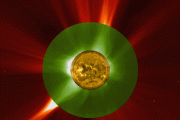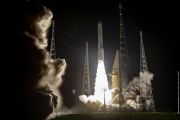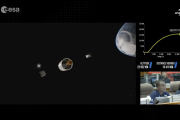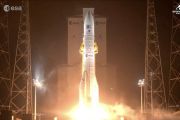
Copernical Team
Neumann Space Achieves Milestone with First Molybdenum-Fueled Thruster Test in Space
 Neumann Space, an Australian-based innovator in space technology, has recently made headlines with the successful completion of the first series of on-orbit tests of its Neumann Drive, a leading propulsion system designed for small spacecraft. This significant achievement marks Neumann Space as the first commercial entity to fire a thruster in space that utilizes Molybdenum, a solid metallic pro
Neumann Space, an Australian-based innovator in space technology, has recently made headlines with the successful completion of the first series of on-orbit tests of its Neumann Drive, a leading propulsion system designed for small spacecraft. This significant achievement marks Neumann Space as the first commercial entity to fire a thruster in space that utilizes Molybdenum, a solid metallic pro Next-generation methane rocket to be more powerful
 Beijing-based private space company LandSpace has unveiled the ZQ-3 carrier rocket, a new addition to its lineup that promises significant advancements in rocket technology. The announcement, made by LandSpace's founder and CEO, Zhang Changwu, at a recent news conference at the Jiuquan Satellite Launch Center, details the rocket's design and capabilities, indicating a fresh approach in rocket en
Beijing-based private space company LandSpace has unveiled the ZQ-3 carrier rocket, a new addition to its lineup that promises significant advancements in rocket technology. The announcement, made by LandSpace's founder and CEO, Zhang Changwu, at a recent news conference at the Jiuquan Satellite Launch Center, details the rocket's design and capabilities, indicating a fresh approach in rocket en Launch of secret Space Force orbital platform delayed again
 SpaceX has announced further revisions to the schedule for the Falcon Heavy's launch of the USSF-52 mission. The launch, initially set for December 10 and then rescheduled for December 11, is now targeted for no earlier than Tuesday, December 12 at 8:14 p.m. ET. This latest delay stems from a 'ground side issue', marking a deviation from the earlier weather-related postponement. SpaceX has also
SpaceX has announced further revisions to the schedule for the Falcon Heavy's launch of the USSF-52 mission. The launch, initially set for December 10 and then rescheduled for December 11, is now targeted for no earlier than Tuesday, December 12 at 8:14 p.m. ET. This latest delay stems from a 'ground side issue', marking a deviation from the earlier weather-related postponement. SpaceX has also Little Pictures winner announced at COP28

The winning entry to a Europe-wide data visualisation contest was announced and showcased last week at COP28. The ‘Little Pictures’ competition challenged the continent’s creative talent to design compelling illustrations using the range of global observation records available from ESA, the European Organisation for the Exploitation of Meteorological Satellites (Eumetsat) and European Centre for Medium-Range Weather Forecasts (ECMWF), to highlight the key changes taking place across the climate.
Inflight call with Nobel Prize laureates
 Video:
00:00:45
Video:
00:00:45
Live conversation between ESA astronaut and commander of the International Space Station (ISS) Andreas Mogensen and the 2023 Nobel Prize laureates Ferenc Krausz (in physics) and Moungi Bawendi (in chemistry). The event took place at the Nobel Prize Museum in Oslo which was connected to the ISS. Andreas showed a Nobel Prize he brought with him to the Space Station.
Researchers stunned by Webb's view of exploded star

Like a shiny, round ornament ready to be placed in the perfect spot on the holiday tree, supernova remnant Cassiopeia A (Cas A) gleams in a new image from the NASA/ESA/CSA James Webb Space Telescope. However, this scene is no proverbial silent night – all is not calm.
Weather delays Falcon Heavy launch of secret Space Force orbital platform
 SpaceX has announced a revised schedule for the Falcon Heavy's launch of the USSF-52 mission. Initially planned for December 10, the mission is now set for Monday, December 11 at 8:14 p.m. ET. This change is due to weather conditions affecting the planned lift-off from Launch Complex 39A (LC-39A) at NASA's Kennedy Space Center in Florida. A backup opportunity is available at the same time on Tue
SpaceX has announced a revised schedule for the Falcon Heavy's launch of the USSF-52 mission. Initially planned for December 10, the mission is now set for Monday, December 11 at 8:14 p.m. ET. This change is due to weather conditions affecting the planned lift-off from Launch Complex 39A (LC-39A) at NASA's Kennedy Space Center in Florida. A backup opportunity is available at the same time on Tue Astronomers determine the age of three mysterious baby stars at the heart of the Milky Way
 Through analysis of high-resolution data from a ten-metre telescope in Hawaii, researchers at Lund University in Sweden have succeeded in generating new knowledge about three stars at the very heart of the Milky Way. The stars proved to be unusually young with a puzzling chemical composition that surprised the researchers.
The study, which has been published in The Astrophysical Journal Le
Through analysis of high-resolution data from a ten-metre telescope in Hawaii, researchers at Lund University in Sweden have succeeded in generating new knowledge about three stars at the very heart of the Milky Way. The stars proved to be unusually young with a puzzling chemical composition that surprised the researchers.
The study, which has been published in The Astrophysical Journal Le More than a meteorite: New clues about the demise of dinosaurs
 What wiped out the dinosaurs? A meteorite plummeting to Earth is only part of the story, a new study suggests. Climate change triggered by massive volcanic eruptions may have ultimately set the stage for the dinosaur extinction, challenging the traditional narrative that a meteorite alone delivered the final blow to the ancient giants.
That's according to a study published in Science Advan
What wiped out the dinosaurs? A meteorite plummeting to Earth is only part of the story, a new study suggests. Climate change triggered by massive volcanic eruptions may have ultimately set the stage for the dinosaur extinction, challenging the traditional narrative that a meteorite alone delivered the final blow to the ancient giants.
That's according to a study published in Science Advan Tekniam and Rivada Collaborate to Enhance Emergency Communications and Disaster Recovery
 In a strategic alliance aimed at bolstering emergency communications and disaster recovery efforts, Tekniam, a US-based company specializing in emergency connectivity solutions, is joining forces with Rivada Space Networks to use the company's OuterNET system to create a resilient and swiftly deployable network in the face of catastrophic events.
Natural and man-made disasters such as hurr
In a strategic alliance aimed at bolstering emergency communications and disaster recovery efforts, Tekniam, a US-based company specializing in emergency connectivity solutions, is joining forces with Rivada Space Networks to use the company's OuterNET system to create a resilient and swiftly deployable network in the face of catastrophic events.
Natural and man-made disasters such as hurr 
































